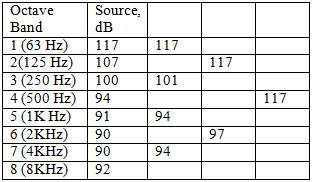Noise Reduction in HVAC Duct Systems
Instead of employing extensive calculations in order to compute sound levels, i.e., what sound will we actually hear if we are exposed to more than one sound source at the same time, it is possible to use short-cut, rule of thumb guidelines:
• Adding a sound source that is 10 dB less than a primary sound source will have no effect on the overall level of sound perceived. The louder sound source masks the quieter source.
• The addition of two equal sound sources will result in a noise level increased by 3dB.
• The addition of sound sources which differ by 2 dB to 4dB will increase the louder noise source by 2dB
• The addition of sound sources which differ by 5dB to 9dB will increase the louder noise source by 1dB
(See Table Simplified Decibel Additions).
Table 3. Guidelines for Simplified Decibel Additions
 |
|
Table courtesy of Kinetics Noise Control, Inc. |
Example: Two sound pressure sources producing 100 dB each do not produce 200 dB when heard together. Rather, according to sound pressure equations, the subjective combined sound pressure level is 103 dB.
Frequency
The frequency of a sound is determined by the number of pressure fluctuations (sound waves) produced per unit of time. Fluctuation in pressure determines the pitch. Sound frequency can be correlated to pitch and is measured in Hertz (Hz), cycles per second. Humans have the capacity of hearing sounds that range from about 20 Hz to 20,000 Hz. Middle C on a piano has a frequency of approximately 260 Hz. One octave above or below has double or half the frequency of middle C.
Noise control is a function of the frequency of the noise source. Frequencies are important because they can be grouped together into octave bands. The overall decibel level from combining sounds from 8 octaves, or bands, can be calculated using the rule of thumb table. See the following four tables for Octave Band Linear Addition
Table 4. Octave Band Numbers and their Center Frequencies
 |
Table 5 and 6. Octave Band Center Frequency Linear Addition
 |
 |
Example of octave band center frequency linear addition combining two noise sources using rule of thumb guidelines from Table 3 Simplified Decibel Additions. Tables courtesy of Kinetics Noise Control, Inc. |
Wavelength
The wavelength of sound is the distance over which the wave shape repeats. Low pitch sounds have long wavelengths. High pitch sounds have short wavelengths. Wave length is important as it directly relates to frequency and helps determine the proper product required to control the noise. The best noise solution is to select a product that allows for multiple wavelengths to pass through the product. The short wavelengths associated with higher frequencies (i.e., 1K , 2K , 4K and 8K Hz bands) of Table 7 make it easier to attenuate noise at these higher frequencies.
Table 7. Wavelengths of Octave Band Center Frequencies
 |
|
Table courtesy of Kinetics Noise Control, Inc. |









